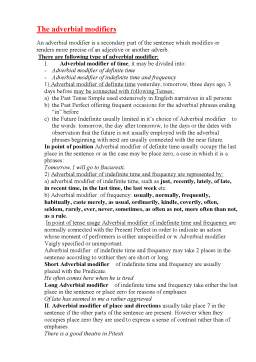Extras din curs
The Indirect Object
Is that secondary part of the sentence which completes the meaning of the verb, indicating the person, the thing or abstract notion, whom or which the action of that verb affects influences or reaches indirectly.
In other words, it shows the person, the thing or the concept indirectly receiving the action of the verb, benefiting by that action or being destined to receive the object of the respective action.
The Indirect Object is in the Dative case and answers the question “whom?” , “to whom?” , or less frequently “to what?” .
The Indirect Object is built up with the preposition “to”, characteristic of the Dative case, or with the preposition “for”. However if it is formed of a single word, especially when it is expressed by a personal pronoun or proper name, the preposition is omitted.
I wrote a letter to him yesterday.
I wrote him a letter yesterday.
Traditional grammar distinguish between 2 possibilities of using or not using preposition by means denominations prepositional Dative/ non-prepositional Dative or prepositional Indirect Object/ non-prepositional Indirect Object.
From a structural point of view the Indirect Object is of 2 kinds:
1) A long Indirect Object (prepositional Indirect Object) preceded by preposition “to” or “for”
2) A short Indirect Object (non-prepositional Indirect Object) are accompanied by a preposition
I. A Preposition Indirect Object
There are the following situation in which are used a Preposition Indirect Object:
1) when a speaker or the writer wants to emphasis the Direct Object or to place it in contrast with another Indirect Object
I brought flower for her.
He gives this advice for his son.
2) While the Direct Object is expressed by pronoun while Indirect Object is expressed by a noun.
He sent him to the manager.
3) when both objects are expressed by personal pronouns
Show them to me.
4) when the Indirect Object is placed at the head of the sentence in the interrogative form
To which of the boys did you give the sweets?
5) When the Indirect Object introduces a relative-attributive clause
The boy to whom I gave the letter, lost it.
6) it is used after the following verbs: to announce, to attribute, to ascribe, to communicate, to contribute, to declare, to describe, to dedicate, to dictate, to explain, to hint, to indicate, to introduce, to interpret, to present, to owe, to point, to propose, to relate, to repeat, to reform, to return, to see, to speak, to submit, to suggest, to talk, to translate.
The position of the Indirect Object
Although theoretical the Direct Object should perceive the Indirect one in fact in standard English and especially in conversation, this happens only in those cases when the Indirect Object is accompanied by the attributes. As a result quite after the short objective occupies place 3 in the sentence, preceding to Direct Object which takes place 4.
In point of syntactical analyses, the presents of the preposition “to” or “for” in front of an object, may give rise to difficulties in discriminating between Indirect Object and Prepositional Object.
There are the following ways of differentiating them:
1) the essence of the Indirect Object is that of receiving end or of target of a verb of conveyance which is also normally a transitive verb
2) from a formal point of view there is also the possibility to transform the preposition construction into a non-prepositional construction which is permitted only for the Indirect Object
I want you to know what this chance means to me.
I’m appealing to you to help us.
He very often contributes articles to the magazine. (an indirect object).
3) The preposition in such cases is required by another type of relation that the Dative one, a case in which usually confusions arisen in connection with the Preposition Object of relation in the case of verbs of obligatory preposition.
The Preposition Object is the part of the sentence very much controverts in the traditional and modern grammar on account of the fact that some grammarians consider it a particulate of the Indirect Object while others recognize it as a secret part of the sentence. In English Prepositional Objects are grouped in rather formal way, on account of the fact that they are made up of : nouns or nouns equivalents; generally speaking in order to identify the preposition object; one must make sure, first, that the part of the sentence analyzed is somewhat similar to an Indirect Object.
The preposition Object can be defined as a secondary part of the sentence, completing the meaning of the verb in the sentence, of a noun or of an adjective and consisting of a noun or a noun equivalent preceded by a preposition.
In point of form it is to be identify by non-specific question made up of a preposition followed by an interrogative pronoun by whom? In what ? Through what? To which? About what? With whom? Against what? In whose favour?
The prepositional object is closely connected with verbs which take an obligatory preposition or can’t be constructed without the preposition in most of the contexts such as to wait for, to dream of, to aim at, to bose of.
Generally speaking the Prepositional Object may fallen both transitive and intransitive verbs as well as some complex verbs.
Preview document
Conținut arhivă zip
- Curs 1.doc
- curs 2.doc






















